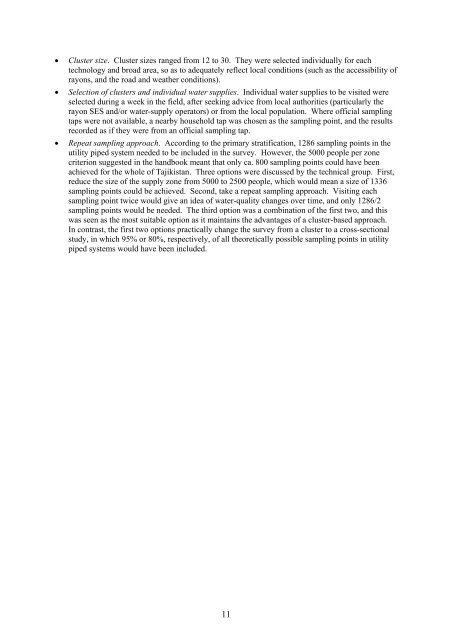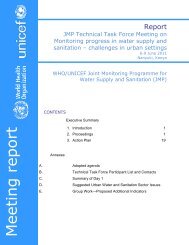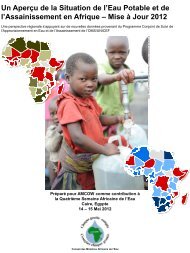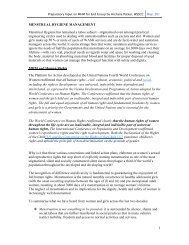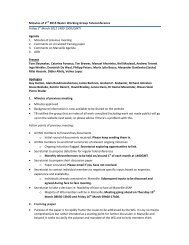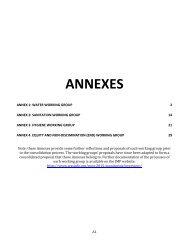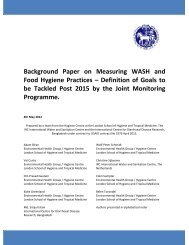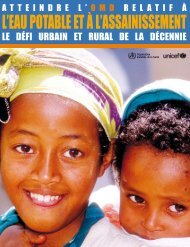rapid assessment of drinking-water quality in the republic of tajikistan
rapid assessment of drinking-water quality in the republic of tajikistan
rapid assessment of drinking-water quality in the republic of tajikistan
Create successful ePaper yourself
Turn your PDF publications into a flip-book with our unique Google optimized e-Paper software.
Cluster size. Cluster sizes ranged from 12 to 30. They were selected <strong>in</strong>dividually for each<br />
technology and broad area, so as to adequately reflect local conditions (such as <strong>the</strong> accessibility <strong>of</strong><br />
rayons, and <strong>the</strong> road and wea<strong>the</strong>r conditions).<br />
Selection <strong>of</strong> clusters and <strong>in</strong>dividual <strong>water</strong> supplies. Individual <strong>water</strong> supplies to be visited were<br />
selected dur<strong>in</strong>g a week <strong>in</strong> <strong>the</strong> field, after seek<strong>in</strong>g advice from local authorities (particularly <strong>the</strong><br />
rayon SES and/or <strong>water</strong>-supply operators) or from <strong>the</strong> local population. Where <strong>of</strong>ficial sampl<strong>in</strong>g<br />
taps were not available, a nearby household tap was chosen as <strong>the</strong> sampl<strong>in</strong>g po<strong>in</strong>t, and <strong>the</strong> results<br />
recorded as if <strong>the</strong>y were from an <strong>of</strong>ficial sampl<strong>in</strong>g tap.<br />
Repeat sampl<strong>in</strong>g approach. Accord<strong>in</strong>g to <strong>the</strong> primary stratification, 1286 sampl<strong>in</strong>g po<strong>in</strong>ts <strong>in</strong> <strong>the</strong><br />
utility piped system needed to be <strong>in</strong>cluded <strong>in</strong> <strong>the</strong> survey. However, <strong>the</strong> 5000 people per zone<br />
criterion suggested <strong>in</strong> <strong>the</strong> handbook meant that only ca. 800 sampl<strong>in</strong>g po<strong>in</strong>ts could have been<br />
achieved for <strong>the</strong> whole <strong>of</strong> Tajikistan. Three options were discussed by <strong>the</strong> technical group. First,<br />
reduce <strong>the</strong> size <strong>of</strong> <strong>the</strong> supply zone from 5000 to 2500 people, which would mean a size <strong>of</strong> 1336<br />
sampl<strong>in</strong>g po<strong>in</strong>ts could be achieved. Second, take a repeat sampl<strong>in</strong>g approach. Visit<strong>in</strong>g each<br />
sampl<strong>in</strong>g po<strong>in</strong>t twice would give an idea <strong>of</strong> <strong>water</strong>-<strong>quality</strong> changes over time, and only 1286/2<br />
sampl<strong>in</strong>g po<strong>in</strong>ts would be needed. The third option was a comb<strong>in</strong>ation <strong>of</strong> <strong>the</strong> first two, and this<br />
was seen as <strong>the</strong> most suitable option as it ma<strong>in</strong>ta<strong>in</strong>s <strong>the</strong> advantages <strong>of</strong> a cluster-based approach.<br />
In contrast, <strong>the</strong> first two options practically change <strong>the</strong> survey from a cluster to a cross-sectional<br />
study, <strong>in</strong> which 95% or 80%, respectively, <strong>of</strong> all <strong>the</strong>oretically possible sampl<strong>in</strong>g po<strong>in</strong>ts <strong>in</strong> utility<br />
piped systems would have been <strong>in</strong>cluded.<br />
11


